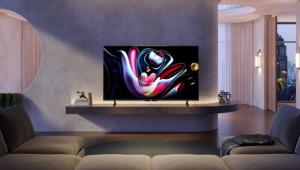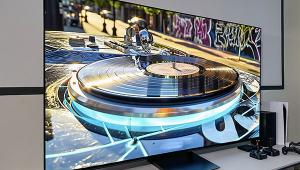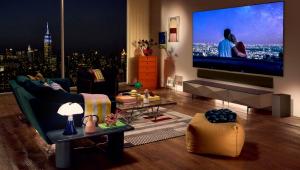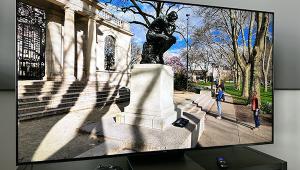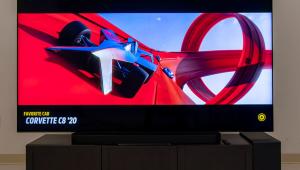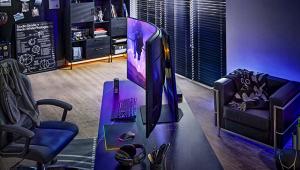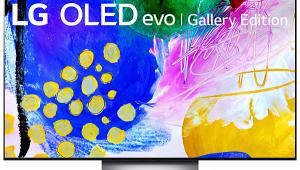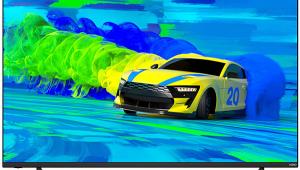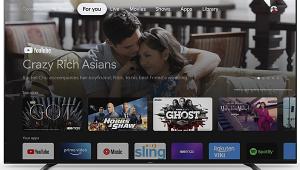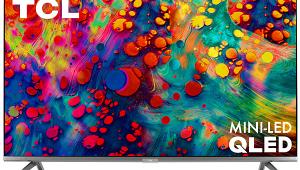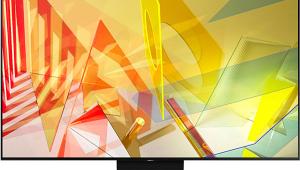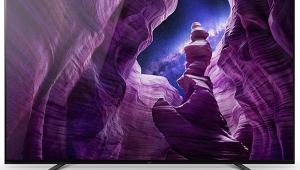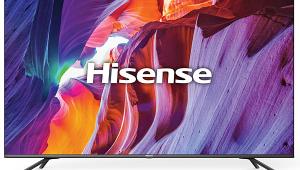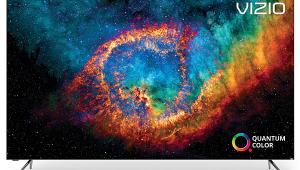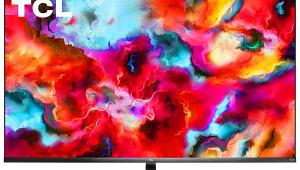The C7P undercuts the Sony by $1000 and bests it in black level and shadow detail.
Sony XBR-65A1E OLED Ultra HDTV Review Page 2
The only reservations I had about the Sony’s black level and shadow detail were on the most difficult scenes. At the beginning of chapter 2 of Prometheus, which begins in total darkness as Dr. Shaw chips away behind a wall, the darkness before she breaks through wasn’t quite total. But it was very close and could be distinguished from full black only in a totally darkened room.
 Ultra HD and High Dynamic Range
Ultra HD and High Dynamic Range
All of my 4K viewing for this report was from UHD/HDR Blu-rays played on an Oppo UDP-203 Ultra HD Blu-ray player. I first settled on the Cinema Pro mode for both SDR and HDR viewing. Most of the user default settings (apart from Gamma and X-tended Dynamic Range) were the same with either type of source, and the set switches between them automatically depending on the information (metadata) it receives at its input. HDR10 sources briefly display an HDR10 bug in the upper left-hand corner of the picture (and will, presumably, display a Dolby Vision indication when the A1E firmware for that format becomes available). In these default settings, the performance was excellent on both SDR and HDR, with HDR displaying its expected benefits, including vivid highlights and good shadow detail. I learned later that by calibrating Cinema pro for SDR, I had essentially calibrated it for HDR as well: When the Sony sees the metadata for an HDR signal, it uses its SDR calibration as the basis for then applying the optimal known offsets for HDR. These changes aren’t visible in the settings menus, but when you see the HDR bug indicating the set is receiving HDR, the altered settings have been magically applied.
Nonetheless, despite the success of this automatic tuning, I quickly found that there was no onboard memory for the user to separately tweak all the critical parameters for SDR and HDR images within the same Picture mode. Of course, some viewers and calibrators will want to do their own optimized, detailed setups for each. To get around this and ensure I could evaluate HDR images with their optimal settings, I ultimately used different Picture Modes for HDR (Cinema home) and SDR (Cinema pro). I then had to manually change picture modes when I switched between SDR and HDR sources. That admittedly became a little tedious, and is obviously not something a typical end user will do, but it allowed me to feel confident I had eked out the absolute best HDR image the set was capable of.
Still, either before or after calibration, the A1E looked remarkable, in nearly every way meeting my expectations for a premium OLED display. While resolution is said to be the least significant advantage to UHD, you couldn’t prove it by what I saw from the Sony. The cleanest, most detailed UHD Blu-rays I watched, including The Great Wall, Allied, and Hacksaw Ridge, looked truly compelling regardless of the quality of the movie itself.
The Great Wall is no cinema classic, but its production values and picture quality made it highly watchable. In particular, it showed off the rich color quality UHD is capable of. The multi-colored uniforms were only a start. The brilliant colors in the capital’s throne room, particularly the emperor’s golden garb, were eye-popping. And near the end of the film, when the action moves to a tower filled with stained-glass windows, the colors of the windows themselves, together with the streaks of multicolored light filtering through them, made for a brilliant conclusion.
 That goes for the rich colors in Trolls as well. Its colors, together with the vivid sense of near-threedimensionality the Sony’s HDR produces, goes a long way toward making this animated film more fun to watch than it’s given credit for. Even though OLEDs can’t match the peak HDR light output of an LCD/LED set like Sony’s Z9D, the dynamic range and highlights the A1E brings to the party don’t disappoint. The shadows, bright scenes, and bright highlights were convincingly demonstrated in Allied, perhaps one of the best UHD discs I’ve experienced so far for showing off the strengths and weaknesses of UHD displays. Nothing spectacular here, just superb photography combined with scenes that vary from bright sunlight to dark shadows. In almost every scene, the Sony excelled.
That goes for the rich colors in Trolls as well. Its colors, together with the vivid sense of near-threedimensionality the Sony’s HDR produces, goes a long way toward making this animated film more fun to watch than it’s given credit for. Even though OLEDs can’t match the peak HDR light output of an LCD/LED set like Sony’s Z9D, the dynamic range and highlights the A1E brings to the party don’t disappoint. The shadows, bright scenes, and bright highlights were convincingly demonstrated in Allied, perhaps one of the best UHD discs I’ve experienced so far for showing off the strengths and weaknesses of UHD displays. Nothing spectacular here, just superb photography combined with scenes that vary from bright sunlight to dark shadows. In almost every scene, the Sony excelled.
The blacks and shadow detail on the Sony were what you’d expect from a modern OLED—exceptional. On a few films, however, the blacks on fade-outs between scenes, and the blacks behind white titles at the beginning and end of those films, were a shade lighter on the Sony than on LG’s 65OLEDE7P, which I also had on hand during evaluation. While this might have been associated with settings on the two sets in a side-by-side comparison (see below), altering the settings on one or both sets didn’t materially change the result. Still, it was a minor detail in an overall exceptional performance, and in all but one or two UHD films that were clearly dicey transfers. The Sony’s black bars, when present, were totally black.
Comparison: LG OLED65E7P vs. Sony XBR-65A1E
In this corner, weighing in at a svelte 51 pounds, we have LG OLED65E7P, veteran of the OLED Wars and the descendant of several generations of 4K fighters. In the opposite corner, we have a worthy opponent, Sony XBR-65A1E, the half-sibling of the E7P but in important ways every inch his own man. (Note that the more price-competitive LG C7P model mentioned earlier offers the same image quality as the E7P used in my comparision.) I began with the two sets side by side, driven by an Oppo UDP-203 UHD Blu-ray player. My only concern here was image quality, both in SDR and HDR10. But I must say that the Sony’s unique audio configuration gave it significantly better sound. This might be an important consideration for those who’ll do a lot of viewing without firing up an outboard sound system.
First, 1080p HD. I viewed both sets in their calibrated settings, which gave them a peak brightness difference of no more than 2 to 3 foot-lamberts at an average level in the low 40-ft-L range. The differences in their color were subtle, despite the LG offering more color control in the form of its color management system. But while both of them offered plenty of detail, the Sony was subtly but visibly crisper looking, which may well have been due to the quality of its upconversion of plain-vanilla HD sources to the higher pixel density of a 4K display.

Still, the LG pulled ahead in black level. My favorite black level and shadow detail test, Harry Potter and the Deathly Hallows: Part 2, did require some rejiggering of the Gamma controls on both sets (their defaults crushed the blacks on this disc). But after balancing this out, I first watched the scene in which Neville leads Harry and friends through a dark tunnel. As the shot widens to show the characters surrounded by the dark of the cave (31:31 into the film), the gloom surrounding them remained full black on the LG but turned dark gray on the Sony. On the plus side, both sets handled most other dark scenes on this Blu-ray equally well.
When I moved on to UHD/HDR, things became more complicated. The gamma curve for HDR is now called the Perceptual Quantization (PQ) curve. While the peak output here has significance when it comes to the handling of spectral highlights, most of the images in most films fall into the bottom to upper-middle part of the curve. To get the best subjective results from the LG E7, I used the Medium position of the Dynamic Contrast control, with the other settings as shown in the online posting of the LG review. This setting produced a somewhat excessive luminance in the mid to upper portion of the brightness range on the PQ curve—not a bad thing subjectively, though short of PQ purity. But it was very good from low to mid luminance. To subjectively match the Sony to it, I used the settings that will be published for the Sony when that review appears online, with the Sony’s gamma setting on +2. A setting of 0 or +1 produced better measured results but a dimmer picture, putting it at an unfair disadvantage to the brighter LG.
That done, in most ways the two sets ran neck and neck. There was little to choose from in color, at least after I turned the Sony’s Color control down from 50 to 48 (helping to compensate for the fact that the LG offers a color management system while the Sony does not). After this, it was easy to spot color differences between the two sets on full-field color patterns, but with real-world material I never had a color preference for one set over the other.

Much of the time it was also hard to spot any differences between the two sets in terms of their black level and shadow detail. Both displayed rich backs, excellent contrast, and (with widescreen films) invisible black bars even in the darkest room. But sometimes, when the LG faded to black between scenes, the Sony only dropped to dark gray. On Lucy, which in general looked stunning on both sets, the background to the end credits was black on the LG but a dark shade of gray on the Sony. Was the LG pulling these areas down to black when the scene in question was transferred at dark gray? Or was the Sony failing to respond to metadata in the source telling it to go black, and instead showed dark gray? Since this was a rare issue, it’s not possible to say which set was correct.
On Allied, however, a dark rooftop scene at 12:39 showed the LG’s better shadow detail. Not only were the dim rooftops better defined on the LG, but I could easily spot a distinction between dark-gray clouds and the darker night sky next to them. On the Sony, it merely looked like the sky itself was dark gray rather than black. Later, in a nighttime London air raid scene, dark details had more pop on the LG but looked slightly flat and grayish on the Sony. But you’d likely never notice either issue apart from a direct comparison.
Both OLEDs displayed dark vertical streaks on full-field, dark-gray test patterns—clearly a panel issue (recall that Sony uses an OLED panel from LG Display). The Sony also clipped bright whites on the most difficult material I have on hand (particularly on sunlit clouds and frothy surf) from a Samsung test disc (not commercially available). The LG did not. But neither of these was an issue on real-world program material.
Conclusions
OLED is now big time. There were doubts about its viability early on, but it’s now hard to deny the benefits it brings to the UHD party. In recognizing those strengths, Sony has come up with a powerful message. LCD/LEDs might still lead the show in peak brightness, price, and the sheer selection of models available to buyers. But OLEDs make for more than worthy competition, and for those who like what they see from them, Sony has now made your buying choices harder with the superb A1E.
- Log in or register to post comments


Touching the Bias settings apparently has the side effect of elevated black levels according to a few that have tinkered with the calibration far more extensively.
When done properly this part of the equation is already a non-factor. Secondly the gamma is elevated on the Sony by design in the lower regions precisely to give more shadow detail.
And of course the sky is not truly black (when viewed from earth) :D

The problem with OLED models is price cost.
LG moved their C6 and B6 2016 model OLEDs when they cut their price to $3,000. 2017 C7 and B7 models are now competitively price with LED's, at least up to 65"screen size.
Sony just won't move enough of their A1E OLEDs at $4,200.
Personally I prefer Sony's 940E 75"screen size to any 65"OLED.
With the right 4k content the 940E wows. At a street price of $4,200 is a bargain.
Yes the 77" OLED's are visually mesmerizing but their cost (10,000 for LG and $18,000 for Sony) puts them in competition with 4k Projectors (Sony, Epson, JVC, Optoma) that can produce stunning images in 130+"screens.

I hear so many people complaining about the price of OLED TVs (and I agree that Sony seems to be overpricing their models as compared to the ones from LG), but many of these same people wax nostalgic about the bygone Pioneer Kuro Elite plasma TVs from a few years back (and they were beautiful TVs, BTW). But they seem to have forgotten that the pioneer Elite Kuro Pro-151FD 60" beauty had a MSRP of $5800 in 2009. No streaming. No 4K. No HDR or Dolby Vision. I'll bet that list price is at least $6500 after inflation in 2017. You can get a pretty sweet LG E7P with all the bells and whistles you need for about $3500 today.
As I have said: I am not trying to put down the plasmas; they were spectacular televisions, the supreme TVs of their time. But people have very selective memories about things like price. Don't forget, in the late '70s a top-of-the-line VHS VCR could run you nearly $1000!

